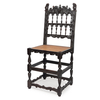Pair of ebony 'Spanish' chairs
Global shipping available
- Origin
- Northern Netherlands, possibly Amsterdam
- Period
- Dated 1633
- Material
- Ebony
- Height
- 101 cm
- Width
- 42.5 cm
- Depth
- 41 cm
- Literature
Jacques Fijnaut TEFAF 2000, pictured in the catalogue.
Questions about this object?
Please use one of the contact options below:
Description
This pair of finely carved ebony 'Spanish' chairs was made in the Northern Netherlands, possibly Amterdam. Dated '1633' on the bottom bar of the the backrest. The backrests of the chairs are decorated with a scene based on a print of Hendrick Goltzius, depicting the story of the Samaritan woman. In this Biblical story, Jesus demonstrates that the faith welcomes the privileged and the poor alike, by asking a Samaritan woman for water. The chairs have baluster turned ebony bars, a toothed sport and seat plinth and they are surmounted by heraldic lions. The bars are decorated with scrolling foliage. Several variations of these chairs are known, both with and without upholstered backrest and seat. They are often depicted on seventeenth-century paintings, for example on those by Frans Hals. The chairs are made of ebony; a precious and valuable material, that was used in The Netherlands from the late 16th century onwards. The costly and tropical material had to be imported and was mostly used for small objects.
The phrase ‘Spanish chair’ is initially used around 1540 in the Southern Netherlands when the guild of furniture-makers in Antwerp used the phrase in one of their texts. The characteristics of a Spanish chair are the high backrest and straight seat that are both upholstered with leather. The top bars are usually surmounted by a lion. The phrase derives from the leather that was made in Cordoba and from the seventeenth century onwards in Holland as well. The current chairs with their beautifully carved backrests with turned bars prove that they were also made without the leather upholstery. Because such bars were also used in Venetian chairs, this may have been influential on the design and popularity of such backrests. They are still called Spanish chairs, after the model. Spanish chairs were mostly made between 1630 and 1650.
The print of Hendrick Goltzius is in the collection of the Rijksmuseum Amsterdam (inv. no. RP-P-H-S-78).
In the collection of the Victoria & Albert Museum in London is a similar chair (inv. no. 443-1892), dated 1678.









